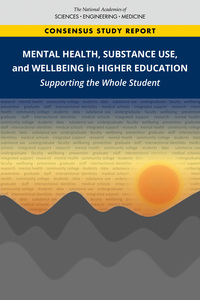Rising rates of mental health problems in U.S. college students require a new response, report says.
The pandemic upended the lives of the nation’s nearly 20 million college and university students sending many away from campus, taking away usual sources of social connection, and amplifying financial stress and fears about the future.
These changes have taken a toll on students’ mental health. Students are reporting higher rates of depression than before the pandemic, and more students say that their mental health is negatively affecting their academic performance.
But even before the pandemic, rates of mental health problems were on the rise. Eighteen percent of students reported experiencing major depression in 2018-2019, compared to 8 percent in 2007. And 14 percent reported thinking about suicide in 2018, up from 6 percent in 2007. Graduate students report depression and anxiety at rates 6 times higher than that of the general population.
“These are frightening statistics, and COVID and its economic consequences are only exacerbating the problem,” said Alan Leshner, CEO emeritus of the American Association for the Advancement of Science.
Leshner chaired a National Academies committee that recently released a report on the subject, Mental Health, Substance Use, and Wellbeing in Higher Education: Supporting the Whole Student.
To respond to the growing problem, the report says, colleges and universities need to take a new, more holistic approach — one that doesn’t just relegate students’ mental health issues to campus counseling centers.
Instead, all sectors of campus — institutional leaders, faculty, staff, and students themselves — need to play a bigger role. “What we are asking is that institutions look at themselves and ask whether there are things in their environment that contribute to the stresses and mental health problems that students are experiencing,” said Leshner.
Schools should consider how, instead of adding to students’ distress, they can positively contribute to their mental health and well-being, the report says. This will require leadership from the top, with presidents and boards of trustees setting the tone, reducing the stigma attached to mental health issues, and articulating the need for campuswide culture change.
Changing campus cultures
One group that should play a key role in improving campus cultures are the faculty, the report says.
“Because they are in such frequent contact with students, faculty have an underacknowledged role in students’ mental health,” said Leshner. “They need to be taught about teaching and mentoring practices that support students’ well-being.”
As an example, the report points to the Texas Well-being program at the University of Texas, Austin, which instructs faculty in how to shift their teaching. For example, it urges faculty to share personal connections to course content — such as areas where they’ve struggled or encountered surprises — and to focus less on competition and performance by students, and more on learning and mastery of content.
Most importantly, the National Academies’ report says, faculty should be taught how to identify and speak with students who could benefit from a mental health referral.
“Faculty and staff can be trained, not to become therapists or counselors themselves, but to recognize students in distress and to be able to refer them to local and community resources that can help them,” said Leshner.
Students, too, should be given structured opportunities to learn about how to support their own and others’ well-being. As a part of formal orientation, for example, students should learn about how behaviors such as sleep, nutrition, exercise, social media, and work both affect and are affected by well-being. They should also be taught how to cultivate a healthy, respectful campus climate — including how to recognize and address implicit bias.
Colleges and universities should regularly and widely provide guidance to students about the mental health support available to them — and must ensure that this help is there when students need it, the report stresses. It urges schools to provide students with access to high-quality mental health and substance use treatment services, either on campus or in the local community.
As schools do so, they should make sure that available resources can support a diversity of students, the report says. Support services should be tailored to the unique histories and needs of individual student populations — and should respond to the fact that many students will have experienced racism and implicit bias both before and during their time in higher education.
Meeting financial challenges
Expanding mental health resources right now will be challenging given the dire financial straits many colleges and universities are facing during the pandemic, the report acknowledges.
“We are well aware that this is a terrible time financially for academic institutions, but it’s essential that they address this problem, or their problems will only be compounded,” said Leshner. “For example, when students are experiencing emotional problems, often they drop out of school.”
This not only harms students but also means that schools lose revenues, the report notes. If necessary, institutional priorities should be rearranged and funds reallocated to support counseling centers and, when appropriate, increased use of online mental health services.
Institutions can improve support for student mental health not only by strengthening services but also by changing policies. For instance, leave of absence and reenrollment policies should allow students who experience mental health and substance use problems enough time for effective treatment and recovery, the report says. Currently, policies often limit how long a student’s leave of absence can last before they must reapply for readmission, and they affect financial aid — barriers that can keep students from returning to complete their education.
Read or download the report or watch a video in which students reflect on their experiences with mental health issues.
Featured Report
2021
 Mental Health, Substance Use, and Wellbeing in Higher Education: Supporting the Whole Student
Mental Health, Substance Use, and Wellbeing in Higher Education: Supporting the Whole Student
Student wellbeing is foundational to academic success. One recent survey of postsecondary educators found that nearly 80 percent believed emotional wellbeing is a "very" or "extremely" important factor in student success. Studies have found the dropout rates for students with a diagnosed mental health problem range from 43 percent to as high as 86 percent. While dealing with stress is a normal part of life, for some students, stress can adversely affect their physical, emotional, and psychological health, particularly given that adolescence and early adulthood are when most mental illnesses are first manifested. In addition to students who may develop mental health challenges during their time in postsecondary education, many students arrive on campus with a mental health problem or having experienced significant trauma in their lives, which can also negatively affect physical, emotional, and psychological wellbeing.
The nation's institutions of higher education are seeing increasing levels of mental illness, substance use and other forms of emotional distress among their students. Some of the problematic trends have been ongoing for decades. Some have been exacerbated by the COVID-19 pandemic and resulting economic consequences. Some are the result of long-festering systemic racism in almost every sphere of American life that are becoming more widely acknowledged throughout society and must, at last, be addressed.
Mental Health, Substance Use, and Wellbeing in Higher Education lays out a variety of possible strategies and approaches to meet increasing demand for mental health and substance use services, based on the available evidence on the nature of the issues and what works in various situations. The recommendations of this report will support the delivery of mental health and wellness services by the nation's institutions of higher education.
Discussion topics:
- Log in to post comments














Latest Comments